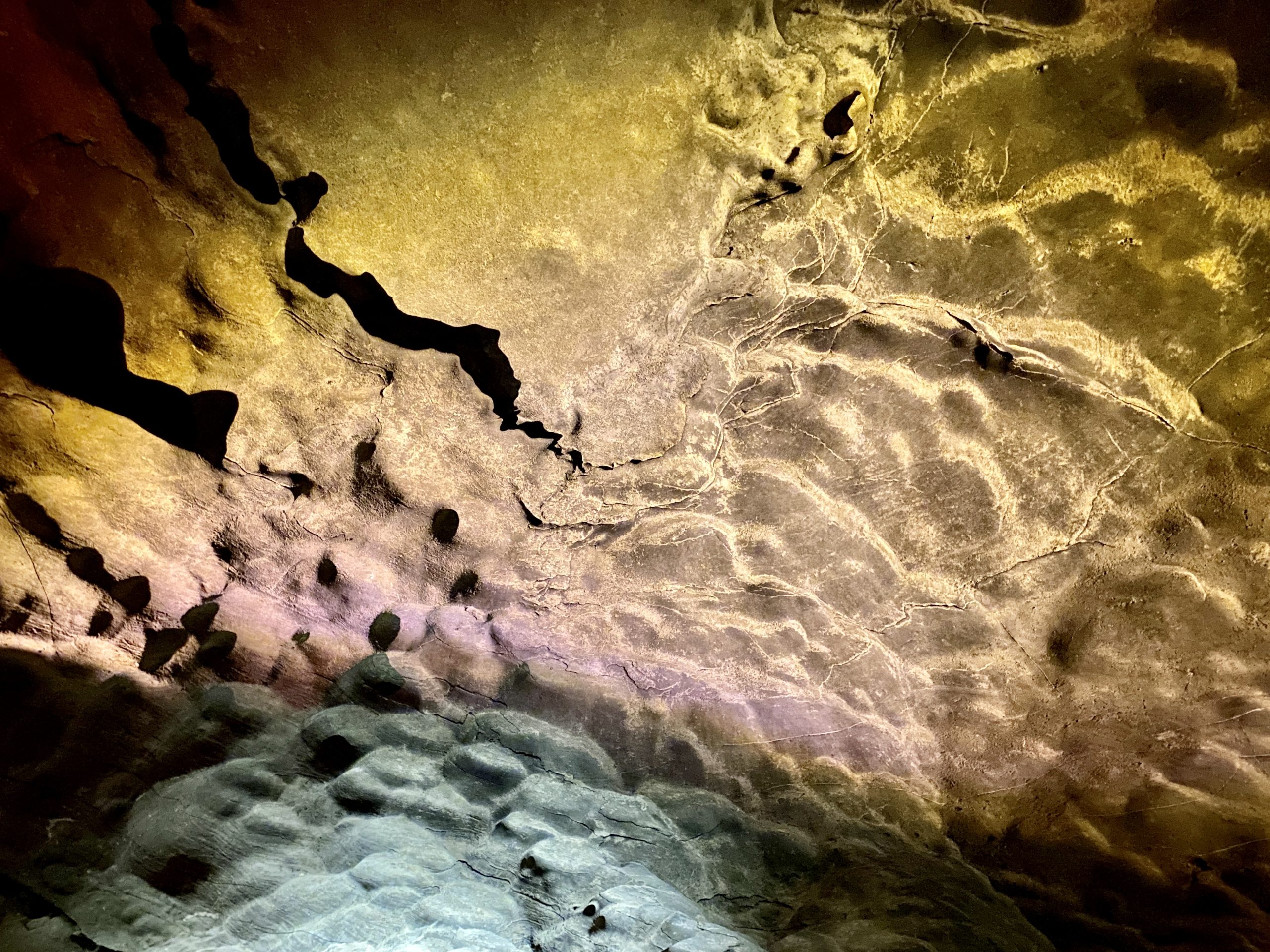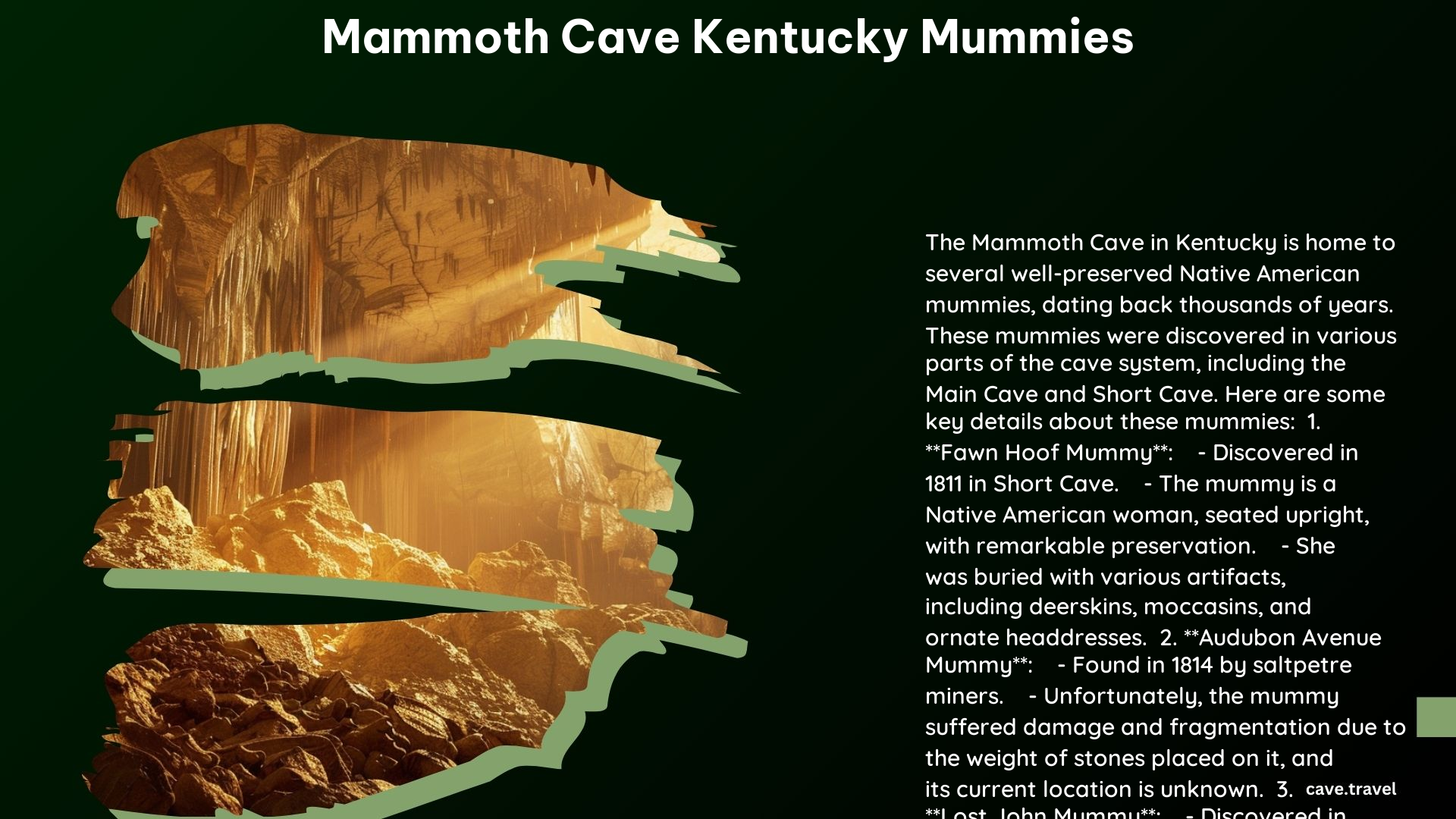The Mammoth Cave in Kentucky is home to several well-preserved mummies, which have been discovered over the years. These mummies offer a unique glimpse into the lives and practices of the Native Americans who once inhabited the region, as well as the fascinating history of cave exploration and preservation.
Fawn Hoof Mummy

The Fawn Hoof Mummy is one of the most well-known and well-preserved mummies found in Mammoth Cave. It was discovered in the late 1811, during saltpeter mining in Short Cave, a few miles south of the main Mammoth Cave system. The mummy was found in a four-foot by four-foot crypt, seated upright with remarkable preservation. The body was wrapped in deerskins and a large square sheet made from inner tree bark fibers.
Accompanying the mummy were various artifacts, including moccasins, a knapsack, and another bag made from inner tree bark fibers. These bags contained items such as a woven head cap, ornate headdresses, bead strings, a necklace with red fawn hoofs, and other items that provide valuable insights into the cultural practices and daily life of the Native Americans who once inhabited the region.
Audubon Avenue Mummy

In 1814, two saltpeter miners discovered another mummy along Audubon Avenue in Mammoth Cave. Unfortunately, this mummy suffered extensive damage and fragmentation due to the weighty stones placed on it, diminishing its value and interest for researchers and visitors.
Lost John Mummy
The “Lost John” mummy was discovered in the 1930s, in the southeastern stretches of the Main Cave. This mummy was crushed under a limestone block while the miners were digging for gypsum. Despite the damage, the body was desiccated and preserved due to the presence of sodium nitrate in the cave sand.
An autopsy of the Lost John mummy revealed valuable information about the diet and lifestyle of the individual, including the discovery of hickory nuts and sunflower seeds in the stomach. Isotopic dating of the intestinal tissue placed the mummy at around 15 B.C., while the cloth associated with the body was dated to approximately 445 B.C.
Preservation Methods
The natural environment of the Mammoth Cave played a crucial role in the preservation of these mummies. The presence of sodium nitrate in the cave sand helped prevent decay and mold growth, allowing the bodies to remain remarkably well-preserved over the centuries.
After their discovery, the mummies were further preserved using various methods, such as cleaning with solvents, impregnating with thymol, and placing them in air-tight cases with dehydrating agents to maintain a dry environment.
Tours and Access
Visitors to Mammoth Cave can experience the history and significance of these mummies through various tours, such as the Mammoth Passage Tour, which passes through Audubon Avenue where the Audubon Avenue Mummy was discovered.
However, the mummies are not currently on public display, with some having been reburied in the 1970s. The exact locations of the reburied mummies are known only to the Mammoth Cave superintendent and a few other individuals.
Historical Significance
The discovery of these mummies has provided invaluable insights into the lives and activities of the Native Americans who once inhabited the Mammoth Cave region. The artifacts and remains found with the mummies offer a glimpse into their mining activities, burial practices, and cultural traditions.
Furthermore, the discovery of these mummies has contributed significantly to the understanding and tourism of Mammoth Cave, one of the world’s longest cave systems. The mummies have become an integral part of the cave’s history and continue to fascinate visitors and researchers alike.
References:
– National Park Service. (1939). Preservation of the Mammoth Cave Mummy. Retrieved from https://www.nps.gov/parkhistory/online_books/regional_review/vol3-4-5h.htm
– National Park Service. (2021). Native Americans. Retrieved from https://www.nps.gov/maca/learn/historyculture/native-americans.htm
– Flickr. (2017). Mummy Ledge (Main Cave, Mammoth Cave, Kentucky, USA) 1. Retrieved from https://www.flickr.com/photos/jsjgeology/38240626946
– Great American Hikes. (2023). The Mummies of Mammoth Cave. Retrieved from https://www.greatamericanhikes.com/post/the-mummies-of-mammoth-cave
– The Little House of Horrors. The Mammoth Cave. Retrieved from https://thelittlehouseofhorrors.com/the-mammoth-cave/
